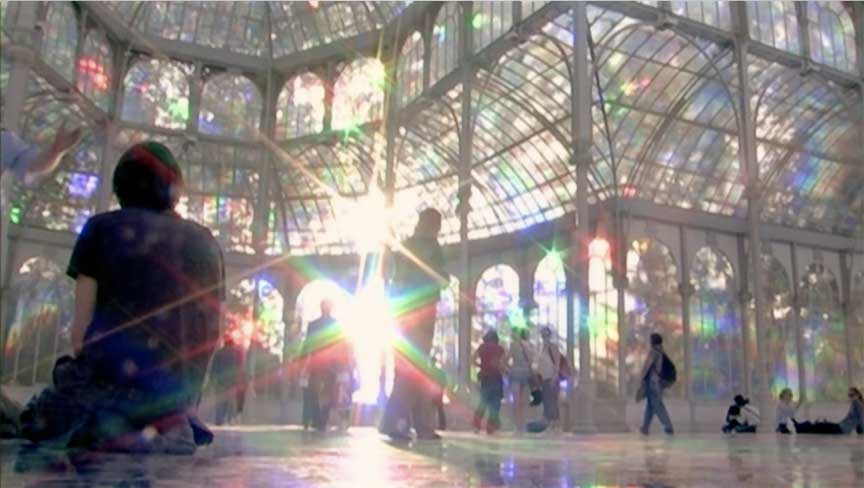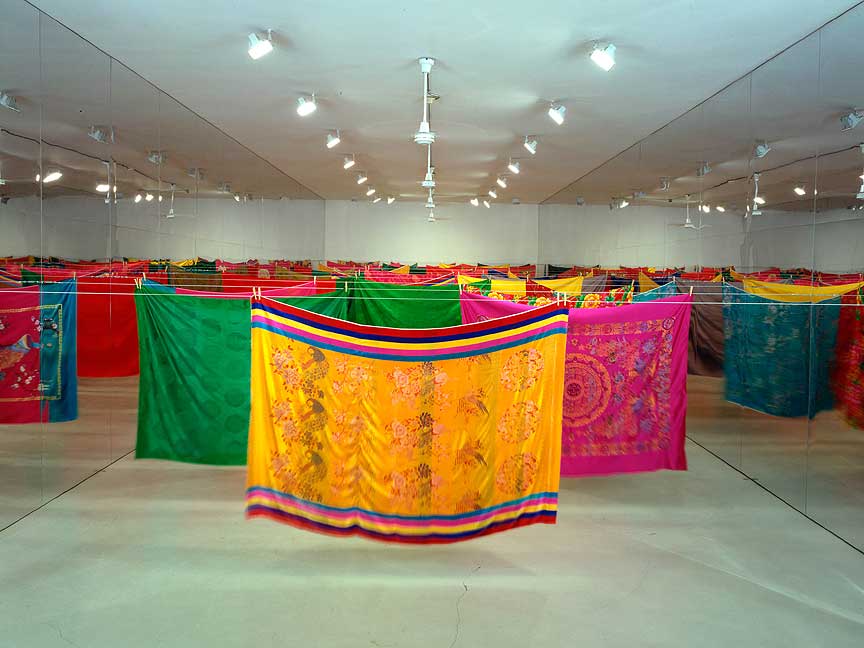Interview
It Was Just a Dream

Kimsooja. To Breathe—A Mirror Woman (2006), installation at The Crystal Palace, Madrid. Production still from the Art in the Twenty-First Century Season 5 episode, Systems. © Art21, Inc. 2009.
In this interview, conducted in 2008 at Kimsooja’s Hudson Street Studio in New York City, the artist discusses becoming an artist, her earliest influences, and her “breathing room” installations.
ART21: What is your earliest memory of making something creative?
KIMSOOJA: In Korea, we lived in a house with a straw roof and it was a really, really cold. Even though we had a stove in the room, when I woke up in the morning there was frost all over the walls. I would scratch the frost, making lines and drawings. Maybe that was my first drawing piece. When I would go outside I’d make little sculptures out of the snow or mix it with sugar to make ice cream.
ART21: And the idea of becoming an artist, when did that really strike you?
KIMSOOJA: I think I first had consciousness as an artist when I was in middle school. When my art teacher asked me to go to art competitions, I refused it, because I thought art shouldn’t be you know judged that way or given any prize. So I refused to go participate in any competitions. So I think I was already aware of being an artist or of my identity as an artist.
ART21: How old were you?
KIMSOOJA: Thirteen or fourteen years old I think. But I always had a dream of being an artist when I was a little girl. Of course, it was just a dream, nothing really particular. When I was at public school in fifth grade, my teacher asked us to put down two different occupations we wanted to be. I don’t know why he asked that two different ones, but I put one as a painter and the other as a “speaker,” without knowing I meant philosopher—a speaker not to the public, but who gives wisdom to the people. In 1994 when I was preparing my show in Korea, I realized I had been doing both art and philosophy.

Kimsooja in her studio, New York City, 2008. Production still from the Art in the Twenty-First Century Season 5 episode, Systems. © Art21, Inc. 2009.
ART21: Tell me about the philosophy part. Explain how the art and philosophy where manifesting together.
KIMSOOJA: All the questions I had as an artist personally and professionally were always linked to life itself. And I saw art in life and life as art. I couldn’t separate one from another. So my gaze to the world and my questions were always related to life itself.
ART21: What sorts of questions were you posing for yourself? Were there issues or questions that troubled you or provoked you?
KIMSOOJA: It’s very personal. I actually started sewing pieces, using a needle as a tool, when I prepared bed covers with my mother in 1993. And that was the moment when I was also searching for the structure of the world—the inner structure of the world—and also searching as a painter for the structure of the surface. I was mostly interested in vertical and horizontal structures at the time, so I’ve been trying to see every single hidden structure in that perspective and then trying to find the right methodology to express that. When I was putting a needle into the silky fabric, I had a kind of exhilarating feeling, like my head was hit by a thunderbolt. And I felt the whole energy of the universe pass through my body and to this needle point through the fabric. I just was so struck by that fact and I thought, “This is it. This is the structure I was looking for.” And it was interesting, too, because the fabric itself had a vertical and horizontal structure in it. And the sewing had another circulative, performative element, but at the same time, always the connection between art and life. And that’s how my work started, from just daily life activities.
ART21: Talk more about the path to becoming artist. There seems, to me, to be a little discrepancy between thinking of Korea as a closed society, where the roles are very defined, yet it was okay to go to art school.
KIMSOOJA: Korean people are really focused on education. They believe it’s the only way to pursue a better life, or reach a higher level of society, because the country’s very small and very competitive. There’s not so much land and job variety, so parents will sacrifice their entire lives for their children. My father and mother were very open. I was raised in a liberal way. For example, my mother would never say no to anything; she always let me do whatever I wanted. I wish she had said no sometimes, because I might have had an easier time in life. But I do appreciate her letting me choose my own way, so that I could learn a lot and be independent and strong. I think my experience was quite unusual—most Koreans are very restricted and follow traditions and family rules. But society is changing and younger generations are more liberal and can be more independent.

Kimsooja. Bottari, 2000. Installation at Partage d’exotismes, 5th Lyon Biennale, 2000. Used bed covers and used clothes; dimensions variable. © Kimsooja. Courtesy of the artist.
ART21: When you were in art school in Korea, did you study any of the traditional art forms? What were you looking at when you were a student?
KIMSOOJA: I studied all the practices—drawings, oil paintings, Oriental traditional paintings, and some sculpture. We didn’t have photos or video classes at the time. It’s a strange thing to say but I actually majored in Western paintings. That meant like I had to make oil paintings and learn Western art histories as well as Oriental art histories.
ART21: Who did you think were the masters when you were a student? Who’s work fascinated you?
KIMSOOJA: When I was a little girl, Cezanne influenced me. But my interests changed over time. I think the most influential artist for me was John Cage. Right after I graduated the college, while I was staying in Paris, he had a piece at Paris Biennale. It was an empty container, but there was a panel all the way along the corner of the floor, written in French. In English I would say, “Whether you try to make it or not, the sound is heard.” And I was just touched by the statement. And I immediately thought, “He is the master.” Since then, I really think I tried to find a way not to make things. So I’ve been using a lot of found objects in daily life—not really touch much or make things but to present as is, questioning different issues. Bottari was also one of them. Bottari is actually everywhere in our country. We always keep bottari, which means bundle in Korean, in our family, to keep things and protect them or to put aside in attic, or to carry from one place another. Also in Korea, “making a bundle” (when it refers to women) means leaving the family—that is, the woman leaves her own family to pursue her own life. I first discovered bottari as two-dimensional painting and, at the same time, three-dimensional sculpture during my residency at P.S. 1. When I look back, there was a bottari that I made, which looked totally different from the ones before. I didn’t realize it because I always had bottari to stack, and keep fabrics in. Bu then I saw it was a sculpture and, at the same time, as a wrapped painting made by only one knot. So I started working on that from a formalistic point of view, with the existing objects, not making something new.
ART21: Tell me when your thinking about the bottari changed—the point when it became more than a bundle to you?
KIMSOOJA: When I returned to Korea, where the bottari is our reality, I started seeing them in different way, more realistic way, and more critical way than before. And I also realized as a woman artist the conflict in our society in terms of women’s position and women’s role. So bottari became a more social, culture-related object than formalistic sculpture.
ART21: What was the thing that caused the switch and how does that relate to women’s roles?
KIMSOOJA: I was frustrated when I left New York and went back to Korea, but I didn’t realize it until later. Living in New York for one year had changed my point of view and I saw Korean society more critically and the condition of women there more frustrating. When I came back to New York again, I started looking at bottari in a formalistic way, as spatial and time dimension, more as sculpture or as painting. But when I returned to Korea I saw it more as kind of a loaded memory and history and frustration that also had time and space in it. So in a way bottari had an even broader and deeper meaning for me.
ART21: Does the bottari represent your work with your mother, or women’s work?
KIMSOOJA: When I was doing sewing pieces, I considered all the women’s activities—sewing, cooking, laundry, pressing, cleaning the house, shopping, decorating—as two and three dimensional or performative activities. I wanted to appreciate that aspect and reveal the artistic context. So my work was all, in a way, related to women’s activity, but then it was also linked to contemporary art issues.

Kimsooja. A Mirror Woman, 2002. Korean bedcovers, parallel mirror structure walls, four fans, cable, and Tibetan Monk chant; 62 × 21 1/5 × 13 feet. Collection of MUDAM, Luxembourg. Photo by Bill Orcutt. © Kimsooja. Courtesy of the artist and Peter Blum Gallery, New York.
ART21: Very often you work is seen through a feminist filter and I don’t think that’s really your intent. I think it would be interesting if you articulated your position.
KIMSOOJA: Although I’ve been working a lot using femininity and female activities, I never considered myself as a feminist. The only thing I can agree to it is that “feminist” is part of “humanist.” So I don’t even participate in feminist shows because that really simplifies and limits my ideas. I refuse to be in a specific ism. But my practice can be perceived as in different isms—like conceptualism, globalism, feminism, minimalism. My intention is to reach to the totality of our life in art, so that’s also one reason my practice is quite broad and diverse—to reach that complexity and comprehensiveness.
ART21: What was the impulse to become an artist who is seen as part of the work? How did you take the step from sewing to video?
KIMSOOJA: After doing sewing practices for more than a decade, I started seeing my body itself as a symbolic needle. But at the same time the truth was already embedded in the nature of the needle, because a needle is a tool that is an extension of our hands and body. And the needle itself is a hermaphrodite-tool that has a masculine and feminine side—a healing part and also a hurting part. So how it functions is always ambiguous. The needle had a complexity in it, and I’ve been pulling out different meanings since I first considered my body as a needle. I made a performance using my own body as a symbolic needle, in the first video Needle Woman (1999) in Tokyo. That actually allowed me to broaden my concepts and my practices.

Kimsooja. A Needle Woman, detail, Tokyo (Japan), 1999-2001. Eight-channel video projection, silent; 6min 33sec loop. Locations: Cairo, Delhi, Lagos, London, Mexico City, New York, Shanghai, Tokyo. © Kimsooja. Courtesy of the artist.
ART21: How did you come to the installation at Crystal Palace and how do you position that work within your practice?
KIMSOOJA: To Breathe—A Mirror Woman (2006), an installation at the Crystal Palace in Madrid, is the meeting point of my bottari and sewing practices. I see the piece as a bottari of light and sound and reflection—not really creating something physical but putting the void all the way to the surface of the Crystal Palace window glass, using diffraction grating film that diffuses light into rainbow spectrum. At the same time I connected my voice, my breathing practice, to my sewing practice. A mirror, all over the floor, reflects the whole structure of the Crystal Palace. I thought the space should be empty and that I should use it just as space itself, putting the sound of my breathing inside of it, occupying the whole space.
ART21: It occurs to me that Crystal Palace functions as a body. Is that correct? If so, can you talk about the work as a body?
KIMSOOJA: In this space that is occupied with the sound of my breathing, people feel that they enter into someone else’s body. They try to integrate the rhythm of my breathing with their own and feel the sensation of the rainbows diffused from the film and the reflection from the mirror of the structure. So in a way they experience my body, my breathing, and the audience’s breathing as architecture, but at the same time they create their own rhythm and relate to their own reflections, to the structure within and without, and to discovering themselves. The audience’s body functions as a needle onto the mirror. It’s another way of sewing and breathing, using your eyes.
Interviewer: Susan Sollins. Content Editor: Nicole J. Caruth. Published: October 2013. © Art21, Inc. Artwork Courtesy of the artist.



